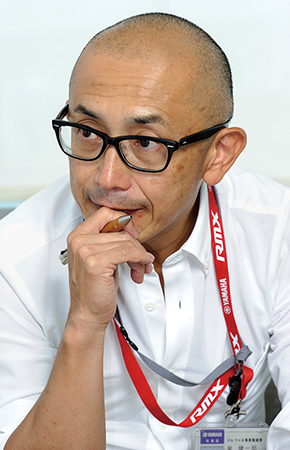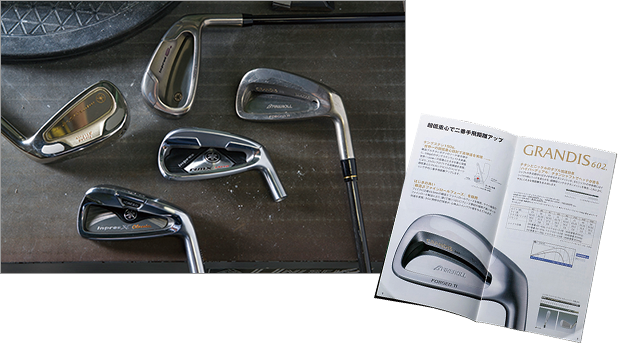All excess trimmed to outperform all-titanium.
180 yards out. What club to use?
A six-iron? How about being able to use a seven- or eight-iron for that distance?
I'd never used clubs that gave me so many options during a round that I couldn't decide which one to use. These "tough" decisions come about because inpres RMX UD+2 irons deliver so much distance. Yamaha sought to add even more distance with the successor model--the inpres UD+2 series irons--so the choice of club comes down to just how far you want to hit the ball.

The bottoms of the faces of the latest irons are L-shaped to expand the high kick velocity area. "Irons are particularly difficult for golfers to hit the center of the club face every time, so by improving the kick velocity performance even when hitting at the bottom part of the face, it will improve carry all the more." (Shiba) The intrepid design should capture an even wider cross-section of fans.
2. Strong Loft: The Beast
Soft iron body enables Yamaha technology to outperform all-titanium
Yamaha iron development manager Kenichiro Shiba waits for us in a room in the development building at the Yamaha Tenryu Plant in Hamamatsu. He has laid out past models of Yamaha's high-distance irons for us to see, and we jumped right into the interview by inquiring about these clubs.
"This model is called the Grandis 602, and the face is made of beta titanium, which was also used in high-repulsion drivers at the time," Shiba answered. "The body is cast pure titanium. The high-strength, lightweight materials improved the repulsion of the face, which in turn improved kick velocity. In addition, we concentrated the weight freed from the face and body into the sole to create a low, deep center of gravity. Back then, no expense was spared to add flight distance to the irons."
That was in the late 1990s, the height of the high-repulsion boom that ushered in demand for unprecedented flight distance, even for irons. Manufacturers came up with irons built for distance to please senior golfers who wanted to be able to enjoy the flight distance from their younger years with irons as well as woods. Yamaha went ahead producing conventional irons, but sold long-distance, all-titanium irons as well. "It's hard to imagine features like all-titanium now when you consider the cost of manufacturing," Shiba chuckled. "Yamaha drew upon its history of engineering irons to search for ways to achieve the same or better results with actual iron. Actually, the bodies of our most recent inpres UD+2 series deliver better flight distance than the all-titanium days using the common material S45C steel."

Golf HS Division
Product Development Group
Irons
Grandis 602 is a set of groundbreaking ultra-strong loft irons, but the lofts in the inpres UD+2 series are two degrees stronger. Nonetheless, the launch angle is high, a testament to many years of research and development.
And these irons aren't just long. Shiba's words about the complete role of irons:
"We are constantly looking to balance lightness and durability. The frame of the body must stay intact, even when relatively weak materials like soft iron are used. Then, we drill down on where some thickness is and is not needed. We free up bits of weight here and there on the club heads, and redistribute it to where it is needed. That part is crucial. Without it, our ultra-strong loft middle irons are nothing more than long irons." Let's take another look at the new inpres UD+2 club heads. The interiors of the bodies--where weight is not needed--are CNC milled to complex configurations.
The upper parts of the frames are carefully crafted to maintain durability. In addition, the thin, L-shaped club faces are made of special spring steel (SAE8655). The weight saved through these efforts and the distinctive design of the club heads enable Yamaha to locate the centers of gravity lower and deeper.
"Although Yamaha began developing long-distance irons in an effort to please senior golfers looking to recover lost flight distance, the previous model [inpres RMX UD+2] was also very well received by the younger generation," Shiba said. "I believe that is likely because those irons helped them reach greens reliably. A good iron gives you distance, but also allows you to take dead aim." If the previous model promised the two clubs longer distance, the latest model has the capability of adding 2.5 clubs. Yet Shiba spoke of the complete role of the ideal iron. Yamaha's pairing of distance and accuracy seems to be the secret behind the success of their UD+2 irons.

The product line started from the desire to help golfers regain the distance they'd lost.
The 2000 product catalog contained the Grandis 602 irons that Shiba showed us. Using beta titanium in the faces and pure titanium for the bodies freed up a lot of weight. This allowed Yamaha engineers to put 100-gram tungsten weights in the soles to achieve ultra-low centers of gravity. The bare titanium club heads had a silvery look that aptly fit the target market of senior golfers. The copy reads "Flight Distance of +2 Clubs!” "That hasn't changed at all, has it?" Shiba grinned.







